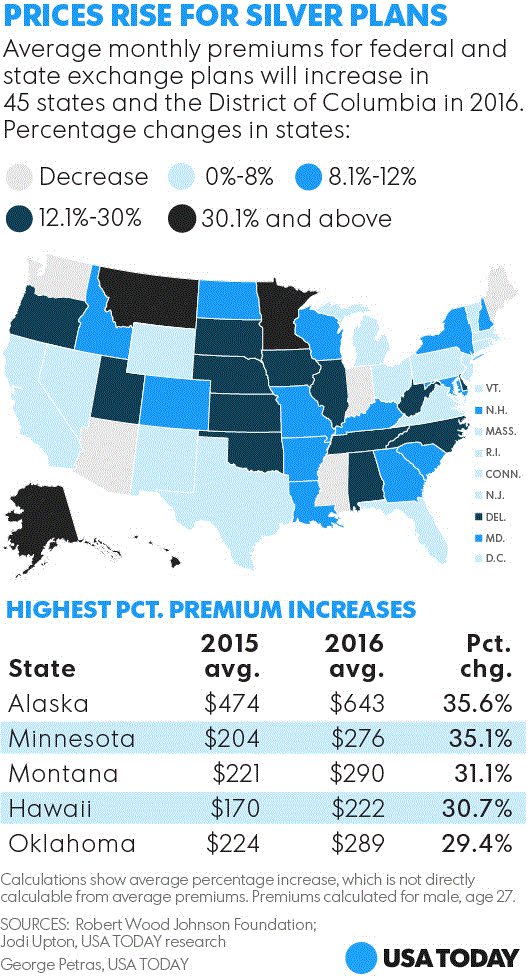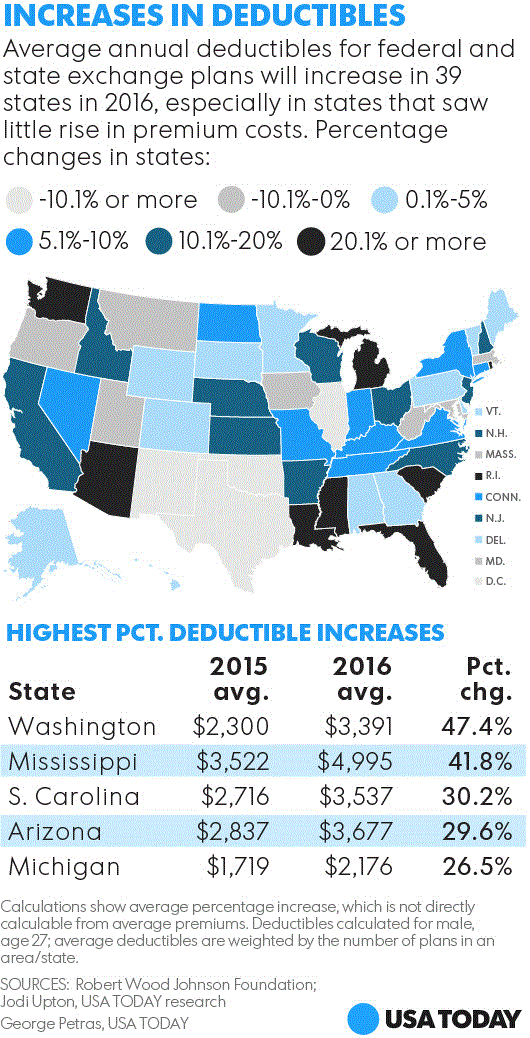State by state data show bigger 2016 exchange premium, deductible jumps
Jayne O'Donnell USA TODAY
10:48 a.m. EST December 16, 2015
Consumers buying health insurance through federal and state exchanges will see their monthly premiums for the popular silver-level plans jump by an average of more than 11%, while also likely facing higher deductibles, a new analysis of exchange data by the Robert Wood Johnson Foundation shows.
These increases will hike the cost of health insurance especially for customers who don't receive federal subsidies to buy insurance, which may also limit the number of people insured under the Affordable Care Act.
Average health insurance premiums for silver plans rose to nearly $300 a month for a 27 year old male, while deductibles were up 8%.
The increases are even more dramatic in the gold-level plans, which have higher premiums but require consumers to pay less out of pocket for their care. These plans's premiums increased nearly 14%, but deductibles dropped just under 1%, according to the the data set, which will be released Wednesday. It is the only publicly available data with details on all of the insurance plans in 50 states plus Washington, D.C.
"A lot of the insurers talked about how they priced too low and claims exceeded premiums for a lot of them, so therefs been an adjustment," says Katherine Hempstead, RWJF's director of insurance coverage. "Going forward you really would expect to see the market stabilize."
The higher premiums exceed the 7.5% average increase the Obama administration has highlighted for the benchmark silver plan for the 37 states using the federal Healthcare.gov exchange in 2015 and 2016. They also highlight the administration's challenge in persuading people who don't receive big subsidies to buy insurance to pay more for plans that have increasingly higher deductibles.
Key points from the 2016 date include:
• The average family deductible soared in states including Washington state, where it was up 76% or about $3,500 a year; Mississippi, where it shot up 42% and South Carolina, which saw a 37% increase.
• In North Carolina, premiums and deductibles for silver plans increased on average by about 20%.
• Alaska had the biggest average premium increase — 35% — for a 27-year-old male. Three other states — Minnesota, Montana and Hawaii — all saw increases of more than 30%.
• Twenty-nine states have fewer gold plans and five states are losing more than half of their gold plans.
This benchmark plan is used to determine the amount of tax credits those under 400% of the federal poverty limit get. Those who make under 250% of the poverty limit, or about $50,000 for a family of three, are also eligible for subsidies that reduce their out of pocket costs. The Centers for Medicare and Medicaid Services (CMS) says about 70% of consumers will pay $75 or less for a plan this year. About 80% of people get tax credits to lower their monthly premiums.
That makes these premium and deductible increases far more of a concern for middle-class consumers.
Although the 7.5% average premium increase for the benchmark plan was higher than the 5% increase in 2015, the Department of Health and Human Services said in an October report that "this rate increase is relatively modest compared to those in the individual market before the Affordable Care Act, when consumers in the individual market regularly experienced double-digit rate increases on average."
Thatfs not necessarily the case, however, when all of the states and bronze and gold plans are considered, RWJF's "HIX Compare" data show. Bronze plans, which have the lowest premiums, had more than a 13% average premium increase for a 27 year old male and deductibles also increased 13%.
But prices for individual insurance plans before and after the ACA arenft a good comparison, Hempstead says, because Obamacare plans today cover much more than they used to and prohibit discrimination on the basis of preexisting conditions. Health economist John Goodman, who advises many members of Congress, said the comparison does not work because the recession at the end of the last decade skewed the the cost of health care, not the new law.
CMS encourages consumers to avoid price increases by shopping around for new policies, and Hempstead says there is a wider range of prices within the 2016 plans, which reinforces the need to compare prices.
About half of customers don't shop around, Goodman says, because they don't want to change doctors and hospitals, adding that many insurers use a limited network of health care providers.
"The price is going up faster than people thought it would and the quality of what's being sold is going down," says Goodman, who is CEO of the Goodman Institute for Public Policy Research.
Insurers have reported losses on its exchange plans, and insurance giant United Healthcare said last month it might drop its ACA policies because it was losing money. David Cordani, CEO of insurer Cigna, said this month that his company was also losing money on the exchanges.
Some see a brighter picture. Late Tuesday, CMS extended its Dec. 15 deadline for Jan. 1 coverage to 11:59 PM to meet what Healthcare.gov CEO described as "overwhelming demand" including a record 1 million callers to Healthcare.gov's call center on Monday. Says Hempstead: "So far it seems consumer interest in enrollment is at least meeting expectations."
CMS plans to release some enrollment data later this week that covers the period through Dec. 15.
Contributing: Jodi Upton

